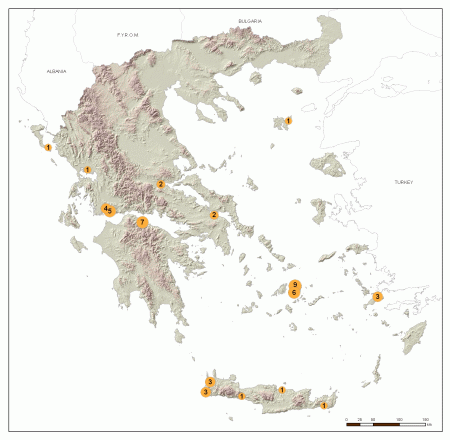![]() The Greater Sand Plover Charadrius leschenaultii is a medium-sized wader that breeds in steppe and semi-steppe areas from the highlands of eastern Turkey to central Asia. After the breeding season it starts a long-distance migration, wintering along the coasts of East Africa, the Indian Ocean and Australasia. A few individuals winter in eastern Mediterranean. Due to its very large and scattered distribution, it is difficult to make an accurate census of its global population, but BirdLife give a rough estimate of 180,000-360,000 birds (Least Concern Species of the IUCN Red List)1.
The Greater Sand Plover Charadrius leschenaultii is a medium-sized wader that breeds in steppe and semi-steppe areas from the highlands of eastern Turkey to central Asia. After the breeding season it starts a long-distance migration, wintering along the coasts of East Africa, the Indian Ocean and Australasia. A few individuals winter in eastern Mediterranean. Due to its very large and scattered distribution, it is difficult to make an accurate census of its global population, but BirdLife give a rough estimate of 180,000-360,000 birds (Least Concern Species of the IUCN Red List)1.
|
![]()
Male Greater Sand Plover, Crete, March 2008 (Colin Turvey)
The third and fourth records both came from the island of Kos, in the Dodecanese, in April 1966 and September 1967 by H. Pieper and R. Koch respectively, but with no further information on the number of birds, locations or exact dates5.
The next six records, all from western Greece occurring between 1989 and 1994 are all cited in The Birds of Greece6.
02. Sterea Ellada, Aitoloakarnania, Mesolonghi, 30-31 August 1954, 2 birds
03. Sterea Ellada, Fthiotida, Agia Triada, 16 September 1954, 6 birds, 1 adult male C.l.columbinus collected
04. Dodecanese, Kos, April 1966
05. Dodecanese, Kos, September 1967
06. Peloponnese, Achaia, Aigio Lagoon, 22-23 June 1989, 1 adult female
07. Sterea Ellada, Aitoloakarnania, Tourlida Lagoon, 2-3 August 1989, 1 adult
08. Peloponnese, Achaia, Aigio Lagoon, 9 August 1990, 1 juvenile
09. Crete, Herakleio, Aposelemis estuary, 4 September 1990, 5 birds
10. Peloponnese, Achaia, Aigio Lagoon, 4 August 1991, 1 juvenile
11. Peloponnese, Achaia, Aigio Lagoon, 26 July 1994, 1 juvenile
12. Sterea Ellada, Attica, Oropos Lagoon, 8 August 1994, 1 adult
13. Peloponnese, Achaia, Aigio Lagoon, 9 August 1994, 1 juvenile
14. Peloponnese, Achaia, Aigio Lagoon, 26 August 1995, 1 juvenile
15. Cyclades, Naxos, Alyki Lagoon, 7 October 1995, 1 bird
16. Crete, Lasithi, Makrygialos, 23 March 1997, 3 adults
17. Sterea Ellada, Aitoloakarnania, Evinos estuary, 3 April 1997, 1 adult male
18. Peloponnese, Achaia, Aigio Lagoon, 12 August 1997, 1 bird
19. Cyclades, Naxos, Glyfada Lagoon, 15 August 1997, 1 juvenile
20. Sterea Ellada, Aitoloakarnania, Evinos estuary, 15 September 1997, 1 bird
21. Crete, Chania, Elaphonisi, 16 January 1998, 1 first winter C.l.columbinus
22. Sterea Ellada, Attica, Oropos Lagoon, 11 June 1998, 1 adult male
23. Sterea Ellada, Aitoloakarnania, Evinos estuary, 24 August 1998, 1 bird
24. Sterea Ellada, Aitoloakarnania, Kleisova Lagoon, 9 September 1999, 1 adult female
25. Limnos, Moudros, Keros, 17 August 1999, 1 juvenile
26. Cyclades, Naxos, Potamides Marsh, 16 June 2001, 1 bird
27. Cyclades, Naxos, Agios Prokopios Lagoon, 11 August 2001, 1 adult female
28. Cyclades, Naxos, Agios Prokopios Lagoon, 16 September 2001, 1 first year
29. Cyclades, Naxos, Alyki Lagoon, 4 September – 3 December 2002, 1 adult male
30. Cyclades, Naxos, Alyki Lagoon, 25 September – 26 November 2002, 1 adult female
31. Crete, Chania, Elaphonisi, 10 November 2004 and 9 January 2005, 1 adult
32. Crete, Chania, Fragokastello, 16 October 2005, 1 adult
33. Epirus, Arta, Koftra Lagoon, 9 July 2006, 1 juvenile
34. Eptanisa, Corfu, Lefkimmi Saltpans, 15 July 2006, 1 juvenile
35. Cyclades, Naxos, Agios ProkopiosLagoon, 30-31 August 2006, 1 juvenile
36. Cyclades, Naxos, Alyki Lagoon, 4-5 October 2006, 1 adult
37. Cyclades, Naxos, Alyki Lagoon, 8 November 2006, 1 adult
38. Cyclades, Naxos, Alyki Lagoon, 17 December 2006 – 6 September 2007, 2 adults
39. Sterea Ellada, Aitoloakarnania, Kleisova Lagoon, 29 September 2007, 1 adult
C. l. columbinus
40. Crete, Chania, Viglia, 12-13 November 2007, 1 adult
41. Sterea Ellada, Aitoloakarnania, Kleisova Lagoon, 1 December 2007 and 13 January 2008, 3 adults C. l. columbinus
42. Crete, Chania, Viglia, 4 January and 3-5 March 2008, 1 adult male C. l. columbinus
43. Cyclades, Naxos, Alyki Lagoon, 29 February – 1 March 2008, 1 first winter
44. Cyclades, Naxos, Glyfada Lagoon, 17 and 19 August 2008, 1 adult C. l. columbinus
45. Dodecanese, Kos, Tigaki Lagoon, 7 and 12 September and 5 October 2008, 1 adult
46. Crete, Chania, Elaphonisi, 12 September 2008, 1 adult
47. Crete, Chania, Viglia, 2 November – 11 December 2008, 1 adult C. l. columbinus
48. Cyclades, Naxos, Alyki Lagoon, 28 March 2009, 1 adult
49. Cyclades, Naxos, Alyki Lagoon, 26 September 2009, 1 adult
50. Sterea Ellada, Aitoloakarnania, Kleisova Lagoon, 15 November 2009, 5 adults

Most of the observations come from the wetlands of southwest Naxos (15), Mesolonghi and Crete (9 each), and from Alyki Lagoon in Aigio (7). The species has not yet been recorded in northern Greece and surprisingly, there are no confirmed records from Lesvos (although there are several unconfirmed reports from Lesvos)8.




